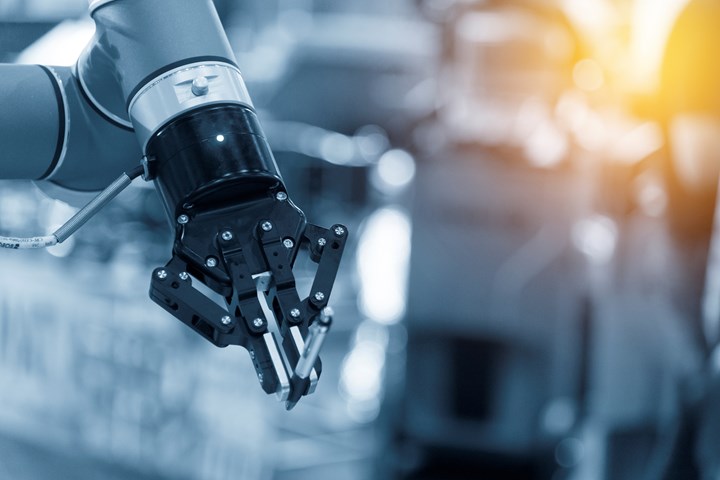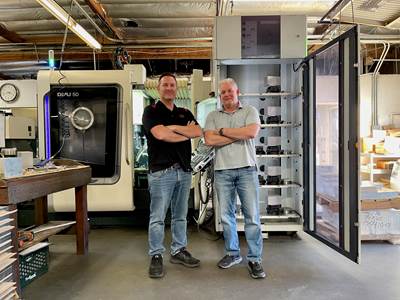Lessons on the Journey Toward Shop Automation
By necessity, small and mid-sized American job shops are automating production, whether through swift, dramatic upgrades in capital equipment, or slow, methodical changes to processes and procedures on the shop floor.
Share





Has your shop employed an automation solution — a process, technology or strategy that led to increased production, improved quality or lights-out machining — that you believe could help the cause of American manufacturing? Please read on.

Earlier this week I had the pleasure of attending a roundtable discussion with DMG MORI President Dr. Masahiko Mori, who made a case for process integration over piecemeal automation strategies as the best means of increasing production and achieving unattended machining. Rather than assigning, say, 10 cobots and five pallet changers to “special purpose” machine tools, he argued, strategic investments in higher-end mill-turn and five-axis machines can drastically reduce the need for these forms of ancillary equipment, and thus increase floor space while reducing energy costs and overall carbon footprint.
Dr. Mori’s analysis went deeper than this, of course, but his general assessment was not an unfamiliar one to the writers of this magazine — including Senior Associate Editor Eli Plaskett and his feature about one shop’s investment in its first HMC. Nor is it unfamiliar to our readers. Dr. Mori’s assessment also happened to be on-point for the topics addressed in this month’s cover feature by Associate Editor Nathaniel Fields.
While major investments in capital equipment are a relatively quick method of achieving unattended production, it is also true that realizing advanced levels of automation is a journey, and that journey takes different paths from shop to shop. Some, like N.C. Engineering (the shop profiled in our cover feature), implement dramatic changes swiftly. Other shops, by will or necessity, engage with new technologies and processes more slowly and methodically. We cannot ignore the fact that, given the impact of today’s interest rates on the desire or ability to secure credit, small and mid-size American job shops may choose solutions that take advantage of existing capital equipment. Thankfully, the array of automation solutions available to even the smallest job shops is expansive — and often accessible — which is why we have dedicated this issue of Modern to covering as many as we can fit into the feature pages of this month’s print edition.
Adding to the two articles mentioned above, Senior Editor Julia Hider examines a carrier system by Lang designed to reduce downtime and allow for unattended machining by transforming existing tool magazines into workholding systems for vises and workpiece blanks. Editor Emeritus Mark Albert investigates new control technology by Heidenhain that allows a CNC toolpath to create a digital twin of the machined workpiece. Albert writes that the system records “a complete digital history of machine motions” during the machining process — a history that represents more than the geometry of the workpiece, but also includes information critical to the performance of the machine and its control system such as torque, speed of axis movements and rates of acceleration and deceleration.
Finally, contributors Chris Caldwell and Sarah Mellish offer an overview of robotic integration for machining operations and other shopfloor applications, including machine tending, mobile robotic solutions and secondary ops including deburring and laser marking.
One of the great joys of putting together the print magazine each month is traveling the country and learning about the ideas and innovations that American machine shops are implementing to increase quality and throughput of CNC-machined parts. Now, we invite you to do the same at our first-ever machine shop technical conference coming this fall. And we want to hear from you.
As I noted in my previous column, Modern Machine Shop is hosting its first-ever technical conference this October 10 and 11 in Novi, Michigan. The Automated Shop Conference (TASC) will feature a widely varied curriculum of technical content geared toward small and mid-sized shops interested in automating production. Attendees also will be invited to a celebratory networking event, as well as a tour of the nearby FANUC America headquarters in Rochester Hills. In addition to keynote presentations, attendees will have the option to select from technical content covering a spectrum of automation solutions aimed at job shops of all sizes.
TASC is an automation conference designed for job shops and informed by the experiences of job shop leaders. If you have something to say about these topics — a teachable lesson about shop automation and a sense of stewardship toward the cause of American manufacturing — we strongly encourage you to submit your request to speak at TASC 2023. Simply click on this link (or visit TASCevent.com and select the “CALL FOR PAPERS” link at the top) to submit an abstract of your idea — just a few sentences that describe your proposed topic. TASC presenters receive free attendance to the conference, prominent positioning in TASC-related marketing material issued by Modern Machine Shop, meal coverage and other perks.
Finally, I’d like to thank FANUC, Universal Robots, Stäubli, SMW Autoblok, Midaco, Reid Supply and all our event sponsors who are making this one-of-a-kind experience possible. And, once again to our readers, I encourage you to mark your calendars for October 10 and 11, sign up for event updates on our website or apply to speak at the event. Because you know better than anyone: Automation is no longer a luxury for American metalworkers. We need the support and shared insights of our entire community to help American manufacturing reach its full potential.
Related Content
Investing in Automation, Five-Axis to Increase Production Capacity
To meet an increase in demand, this shop invested heavily in automation solutions and five-axis machines to ramp up its production capabilities.
Read MoreSame Headcount, Double the Sales: Successful Job Shop Automation
Doubling sales requires more than just robots. Pro Products’ staff works in tandem with robots, performing inspection and other value-added activities.
Read More3 Ways Artificial Intelligence Will Revolutionize Machine Shops
AI will become a tool to increase productivity in the same way that robotics has.
Read MoreIncreasing Productivity with Digitalization and AI
Job shops are implementing automation and digitalization into workflows to eliminate set up time and increase repeatability in production.
Read MoreRead Next
There's Your Waste, Shaw! An Argument for Shop Reinvestment
The fictional Don Walling had it right: Innovation and long-term success for machine shops requires investments in technology and people. Not just one, but both.
Read MoreAn American Manufacturing Story
For manufacturers that choose to move or keep production in the United States, what are the challenges and opportunities that motivate them?
Read More5 Rules of Thumb for Buying CNC Machine Tools
Use these tips to carefully plan your machine tool purchases and to avoid regretting your decision later.
Read More






























